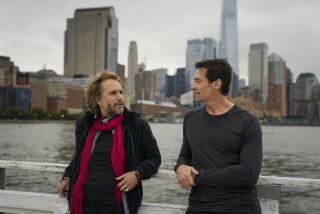Coronavirus shut down production. But Iceland could help Hollywood reopen
Einar Tómasson’s phone and emails had been virtually silent for weeks — until last Wednesday.
It had been nearly two months since the World Health Organization declared the novel coronavirus outbreak a global pandemic, and Iceland’s film commissioner had, like Hollywood and the rest of the world, been waiting out the quiet days of uncertainty as all film and television production halted.
But then, a day earlier, during Netflix’s first-quarter earnings call, content chief Ted Sarandos mentioned that the streaming giant was currently in production in Iceland and South Korea. “We’re taking some of those key learnings about how we run those productions today and applying that to our plans to start our productions around the world,” he said.
All of a sudden, Tómasson was fielding queries from producers and studios in Los Angeles, New York and Europe.
“They’re trying to figure out which markets to enter first,” Tómasson said in an interview from Kópavogur. “They’re trying to map different locations to know which are safe and secure and where they can enter first with potential projects.”
With Hollywood in involuntary hibernation, awaiting the all-clear from public health officials, entertainment companies are frantic to turn the lights on; Sarandos’ comments offered a spark for an industry in the dark.
Iceland, with its sparsely populated but spacious North Atlantic geography, advanced filming infrastructure, production incentives and experienced crews, had long been an attractive shooting location. In recent years, its dramatic landscape of volcanoes, geysers, lava fields and massive glaciers served as the memorable backdrop for “Game of Thrones,” “Prometheus” and “Thor: The Dark World.”
Now Iceland, with its wide-open spaces and vigilant testing, is enjoying another wave of interest from filmmakers, at a time when the ability to contain the spread of the coronavirus has become as important as tax incentives, infrastructure and facilities.
Iceland, which has not been on total lockdown but has mandated social distancing of two meters and gatherings no larger than 20 people, is known for its aggressive testing. According to Bloomberg, as of April 21, it had tested 12% of its population of 364,134 (comparable to the city of Riverside). Iceland’s health authorities report that as of Wednesday, the country had 1,797 confirmed cases and 10 deaths.
Lori Balton, a Los Angeles-based location scout who has been to Iceland multiple times and brought the Darren Aronofsky film “Noah” there, said while she remains cautious, the country appears to tick all the right boxes when it comes to both infrastructure and health measures.
“There is pressure coming from all areas to get production back up again,” Balton said. For her, Iceland offers a potentially attractive option. “Now is a great time to shoot there because there are absolutely no tourists. So if you were out in the country, it would probably be one of the safest places on the planet to be working.”
Film commissions and production companies worldwide have begun touting their advantages as government restrictions start to ease up. Many are sending out emails describing health measures and listing filming conditions and options. “Israel, due to the very early lockdown, is considered to be one of the 3 safest countries in Europe today,” says an email from MV Productions, an Israeli service. The Slovak Film Commission also sent an email to location scouts: “Slovakia is considered as one of the safest countries with low-risk level during the pandemic.”
Hollywood is eager to get back to work after the coronavirus outbreak, but union officials, studio executives and others must first agree on new protocols to make filming safe again.
But in Iceland, according to Tómasson, a big thaw for foreign filmmakers is on the way. On May 4, gathering limits in the country will increase from 20 to 50 — potentially going up to 100 in June. Tómasson and members of Iceland’s film industry have presented the government with a host of proposals intended to capitalize on the country’s small population and expansive geography.
On the table: Foreign crews could take charter flights into the country and be put up at a designated hotel for testing. If the results are negative, crews will be allowed to go onto remote locations, where they will remain in lockdown for the duration of the shoot. Masks and gloves would be deployed on set, as would medical staff. Crews could be tested at the end of shoots before returning home.
Leifur Dagfinnsson, chief executive and owner of Truenorth, a production house that has worked on such films as “Star Wars: The Force Awakens,” as well as the first joint Netflix production, “The Valhalla Murders,” says he has been advising the government about positioning Iceland as a first stop post-coronavirus destination.
“I think the health authorities have dealt with this pandemic quite well,” he said. “My discussions with the government basically suggest what I call controlled tourism,” where tourism infrastructure from hotels to transport, now at a virtual standstill, would be deployed for filming.
Another proposal is to temporarily increase the tax rebate from 25% to 35%. “That would have an immediate impact in getting more business and productions to Iceland,” Dagfinnsson said. He noted that “the Icelandic krona has been devalued 15%,” making it cheaper to film there.
Iceland’s high profile as a film destination began almost two decades ago as a move to diversify the economy beyond fishing and farming.
At the time, two big-name films had shot in the country, 2001’s “Lara Croft: Tomb Raider” and the 2002 James Bond flick “Die Another Day.” Iceland’s rebate program was just 12%. Tómasson was a project manager for the Invest in Iceland Agency, which managed the rebate program.
Tómasson, a former business and marketing executive, became film commissioner in 2004 and took a proactive approach. He asked for a bigger budget that would enable him to travel to Los Angeles and meet with studios and producers.
“I said, ‘I need to make people more aware of why I need to go out there,’” he recalled.
On his first trip, in 2004, he went to a location trade show and met with one independent producer and an executive from Miramax. “I was just learning,” he said.
He and his team soon realized that cultivating location managers and scouts was key.
“We figured out through our conversations that those were the people who were kind of the first creatives on the ground,” said Hlynur Gudjonsson, trade commissioner, Consulate General of Iceland in New York.
They began bringing location scouts on trips to Iceland.
Tómasson also traveled frequently to various trade shows and symposiums to explain the benefits and advantages of Iceland.
The industry received a dramatic boost when Clint Eastwood filmed his 2006 film “Flags of Our Fathers” in Iceland. “It was a big production that had, you know, up to 1,000 people on location,” Tómasson said. “And there was shooting here for almost a month. It showed that we can do big-scale movies.”
The circumstances of Eastwood landing in Iceland, however, were rather serendipitous.
Eastwood’s location manager, Kokayi Ampah, was on the Big Island of Hawaii in April 2005 scouting the black sand beaches with little luck. The main deterrents were nesting turtles and lush flora and fauna. “We were going to shoot battle scenes with tanks that would tear it up,” he said.
From a look at Barack Obama’s White House photographer to a personal production on the streets of Germany, many documentaries are still in production during quarantine thanks to technology, smaller crews and archival footage.
When, on a break to fill up his car, he mentioned to the gas attendant that he was looking for black sand beaches. The attendant recommended he check out Iceland. “I don’t know how he knew about Iceland, but when I got back to the hotel, I looked it up on my computer,” recalled Ampah. Two weeks later he was touring the country’s beaches with the producer, art director and visual effects coordinator, and by summer they were shooting.
Much has changed since then. In 2009 the country’s tax rebate increased to 20%, rising to 25% in 2017. Several large-scale, professional productions houses have sprouted up like Truenorth, as well as a number of post-productions outfits including visual effects firm RVX in Reykjavik. Since 2001, international filming has dramatically increased from two productions to 18 in 2014. Last year there were 11.
While filming his 2012 film “Prometheus,” director Ridley Scott told Icenews, “It is possible to find similar landscapes elsewhere in the world. But here it is so rough and ‘Jurassic-like’ and that proved decisive. Iceland is a massively beautiful country.”
Gudjonsson says he and his colleagues continue to adapt. The past six years they realized that their efforts should focus on television. “We began to understand that it would become a bigger part of the business, which it has.”
Indeed, Netflix’s current production is “Katla,” a supernatural volcano drama by the Icelandic director Baltasar Kormákur. A Netflix spokesperson confirmed the show is a mostly Icelandic crew but declined to comment further on the project or the company’s filming in Iceland.
Many in Hollywood and beyond view this production as a possible northern light forward to rolling back into production.
Iceland and its film industry have weathered a number of knocks, including the collapse of its economy in 2008. Tómasson and others are betting they will successfully withstand the coronavirus and emerge stronger than ever.
After all, not too long ago, the country was hardly on Hollywood’s radar.
Recalling his first meetings with industry executives, Tómasson said, “We basically were like knocking on the door and saying, ‘Hi, we’re from Iceland. Can we tell you what we have to offer?’ Now it’s more like, ‘Hi, we’re in town in a couple of weeks. Can we meet and discuss a couple of projects?’”
More to Read
Inside the business of entertainment
The Wide Shot brings you news, analysis and insights on everything from streaming wars to production — and what it all means for the future.
You may occasionally receive promotional content from the Los Angeles Times.







